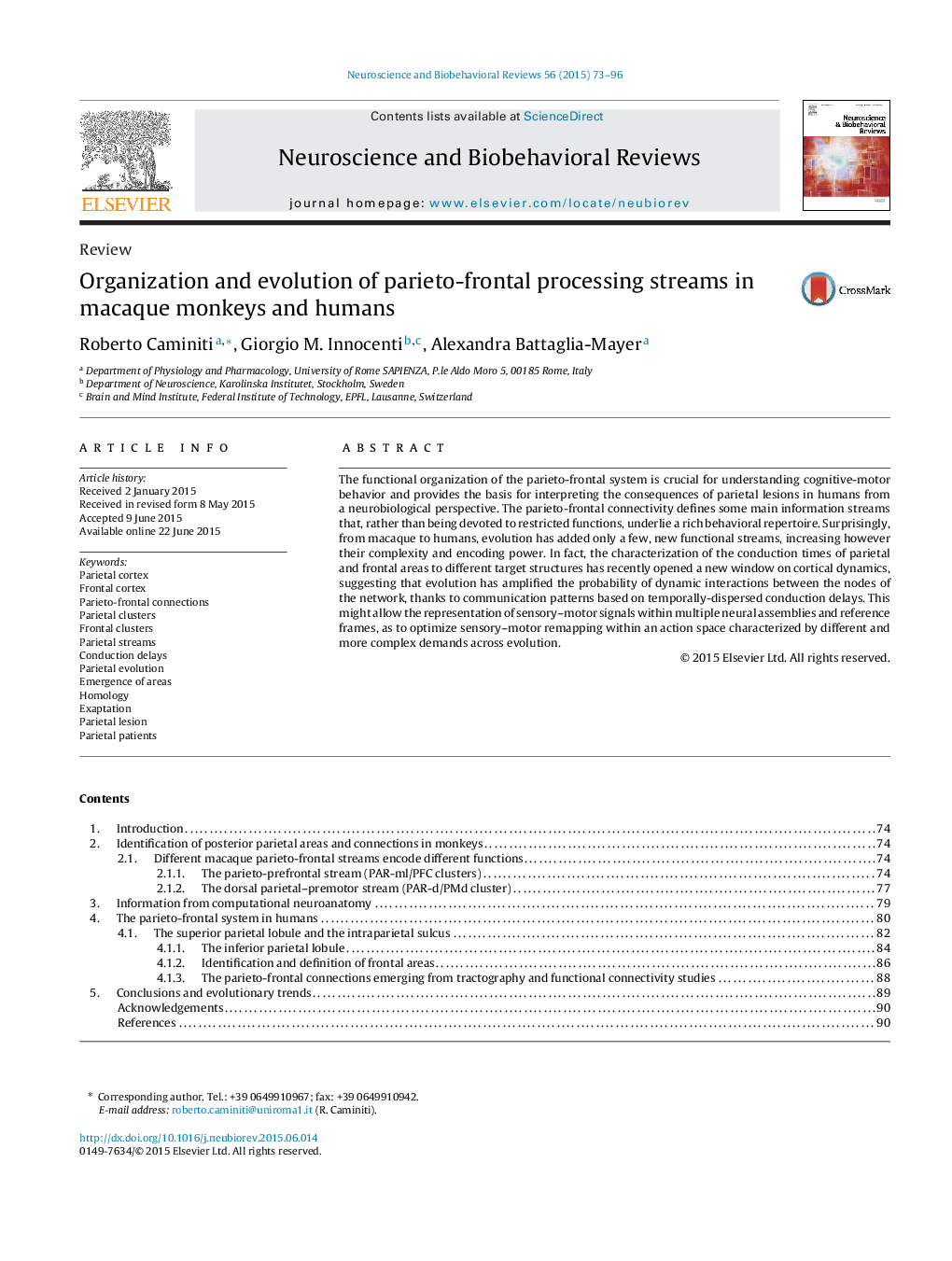| کد مقاله | کد نشریه | سال انتشار | مقاله انگلیسی | نسخه تمام متن |
|---|---|---|---|---|
| 7303267 | 1475314 | 2015 | 24 صفحه PDF | دانلود رایگان |
عنوان انگلیسی مقاله ISI
Organization and evolution of parieto-frontal processing streams in macaque monkeys and humans
ترجمه فارسی عنوان
سازماندهی و تکامل جریانهای پردازش پریتوفرون در میمون ها و انسانهای ماکائو
دانلود مقاله + سفارش ترجمه
دانلود مقاله ISI انگلیسی
رایگان برای ایرانیان
کلمات کلیدی
ترجمه چکیده
سازماندهی عملکرد سیستم پاریتو - فرونتال برای درک رفتار شناختی - حرکتی بسیار مهم است و مبنایی برای تفسیر عواقب ضایعات تیری در انسان از دیدگاه نوروبیولوژیکی است. اتصال به طرف مقابل، برخی از جریان های اطلاعات اصلی را تعریف می کند که به جای اختصاص دادن به توابع محدود، یک رشته فرایندهای رفتاری را پایه ریزی می کند. به طرز شگفتآوری، تکامل از ماکاکس به انسان، فقط تعداد کمی از جریانهای کاربردی جدید را اضافه کرده است، در حالیکه پیچیدگی و قدرت رمزگذاری آنها افزایش یافته است. در واقع مشخص کردن زمان هدایت مناطق حصار و جلو به سازه های مختلف هدف اخیرا یک پنجره جدید بر روی دینامیک قشر را باز کرده است که نشان می دهد که تکامل موجب تقویت تعاملات پویا بین گره های شبکه با توجه به الگوهای ارتباطی مبتنی بر در تاخیرهای هدایت زمانی پراکنده. این ممکن است نمایانگر سیگنال های حسی-حرکتی درون مجموعه های عصبی چندگانه و فریم های مرجع، به منظور بهینه سازی تفسیر حسی-حرکتی در یک فضای عملیاتی با خواسته های مختلف و پیچیده در طول تکامل باشد.
موضوعات مرتبط
علوم زیستی و بیوفناوری
علم عصب شناسی
علوم اعصاب رفتاری
چکیده انگلیسی
The functional organization of the parieto-frontal system is crucial for understanding cognitive-motor behavior and provides the basis for interpreting the consequences of parietal lesions in humans from a neurobiological perspective. The parieto-frontal connectivity defines some main information streams that, rather than being devoted to restricted functions, underlie a rich behavioral repertoire. Surprisingly, from macaque to humans, evolution has added only a few, new functional streams, increasing however their complexity and encoding power. In fact, the characterization of the conduction times of parietal and frontal areas to different target structures has recently opened a new window on cortical dynamics, suggesting that evolution has amplified the probability of dynamic interactions between the nodes of the network, thanks to communication patterns based on temporally-dispersed conduction delays. This might allow the representation of sensory-motor signals within multiple neural assemblies and reference frames, as to optimize sensory-motor remapping within an action space characterized by different and more complex demands across evolution.
ناشر
Database: Elsevier - ScienceDirect (ساینس دایرکت)
Journal: Neuroscience & Biobehavioral Reviews - Volume 56, September 2015, Pages 73-96
Journal: Neuroscience & Biobehavioral Reviews - Volume 56, September 2015, Pages 73-96
نویسندگان
Roberto Caminiti, Giorgio M. Innocenti, Alexandra Battaglia-Mayer,
